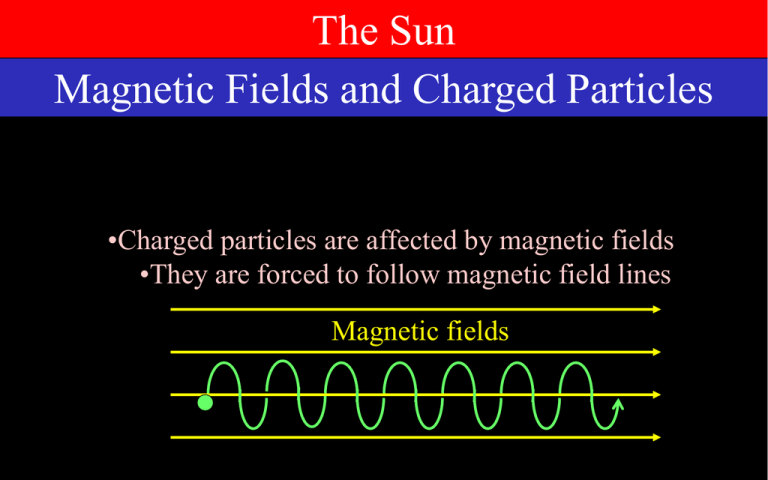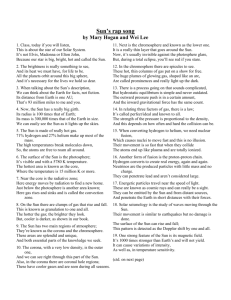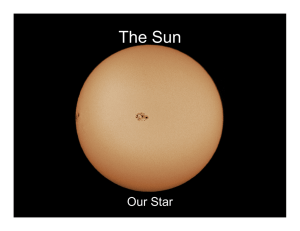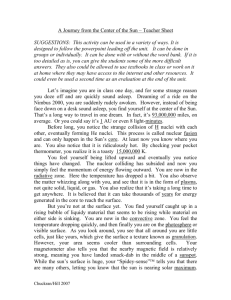The Sun Magnetic Fields and Charged Particles Magnetic fields
advertisement

The Sun Magnetic Fields and Charged Particles •Charged particles are affected by magnetic fields •They are forced to follow magnetic field lines Magnetic fields Plasmas •At ordinary temperatures, atomic nuclei attract electrons to make them neutral •At extreme temperatures, the electrons pop loose, and the electrons can run off freely •This is a plasma •Plasmas are excellent conductors •They can generate magnetic fields Atomic spectra •Suppose you take an atom and bump the electrons up (by heating it, for example). What type of light comes out? •Spectrum consists of emission lines •Exactly which lines tells you the kind of atom, like a fingerprint Atomic spectra •Suppose you take an atom and shine a bright white light on it. What does the spectrum of the light look like when it comes out? •Initial spectrum is continuous •Atom absorbs certain very specific frequencies •The same frequencies you saw before. Kirchoff’s Laws •Hot thick solid, liquid, or gas – Continuous spectrum •Thin gas – bright line spectrum •Thin gas with hotter thick gas behind it – dark line spectrum Kirchoff’s Laws Continuous Spectrum: Hot, thick solid, liquid, or gas Bright Line Spectrum: Hot, thin gas Dark Line Spectrum: Cooler gas in front of hot, thick solid, liquid, or gas Stellar Spectra Star A Spectrum Hydrogen Spectrum From this spectrum you can tell this star A) Is made of hydrogen B) Is made of gas C) Is hot on inside, cooler on outside D) All of the above Stellar Spectra Star B Spectrum Hydrogen Spectrum This star is made of: A) Hydrogen B) Something besides hydrogen C) Part hydrogen, part something else The Sun’s Spectrum •Hundreds of lines •Scores of Elements Composition of a Typical Star (Sun) •Hydrogen •Helium •Oxygen •Carbon •Iron •Neon •Sulfur •Nitrogen •Silicon •Etc. Know These! The Sun: Basic Facts •109 Earth diameter •333,000 Earth mass •Density: a bit higher than water •Rotates once every 25 days •Differential rotation March 1, 2016 from SDO The Sun: How We Know What We Know Exterior •Spectra •Temperature •Motion •Chemical Composition •Magnetic Fields •Ground-based telescopes •Eclipses •Space telescopes •Solar Wind Interior •Gravity •Magnetic Fields •Neutrinos •Helioseismology Solar Dedicated Spacecraft Solar Dynamics Observatory STEREO SOHO Ulysses Outer Layers of the Sun •Photosphere •The layer we see •Sunspots •Chromosphere •Where the dark lines are made •Corona •Prominences •Coronal Holes •Flares •Solar Wind The Photosphere •The point at which gas is thick enough that we can’t see through it •This is a little shallower towards the edge •Limb darkening Here we see shallow and cool Here we see deep and hot Granulation •The Sun’s surface is not uniformly bright •Hot regions of upwelling gas •Cooler regions of falling gas •Convection near the surface https://www.youtube.com/watch?v=W_Scoj4HqCQ Granulation •Granulation changes over time Granulation •Circulation of gases in outer layer •Hot plasma rising, cool plasma falling – convection •Underneath, evidence of circulation on a larger scale •Supergranules larger than the Earth Earth Chromosphere •A cooler layer just outside the photosphere •Light from photosphere lines absorbed from this layer •Bright line spectrum •Visible during eclipses •Red color from spectral line of hydrogen Spicules •Spicules – bright small jets that reach from the photosphere up through the chromosphere •Last about 5 minutes •Cause not understood •Thousands on the Sun at any given time Corona •Thin, extremely hot region •Visible during eclipses If you took a spectrum of the corona, it would be A) A bright line spectrum B) A dark line spectrum C) A continuous spectrum Corona: Temperature •High temperature not well understood •Heated by magnetic fields •Like a whip •Low density – has little total heat Sunspots •Relatively cool regions on a brighter, hotter background •Large magnetic fields What causes them: •Mag. Field sticks out •Plasma can’t flow horizontally •Prevents convection from working •Hot gas can’t rise •Temperature cooler Sunspots - Structure Penumbra Umbra Sunspots often come in groups •Pairs are common •North with south •Larger groups are not uncommon The Solar Cycle •The number of sunspots changes over time •Approximately an eleven year cycle: Butterfly diagram •Sunspots first appear far from the equator •Over time, they become more numerous, and move towards the equator •Then they all disappear The Solar Cycle •Sun’s North/South magnetic pole reverses each cycle •Not all cycles are created equal! •1650-1700, very low level, “Maunder Minimum” •Corresponded to “Little Ice Age” in Europe •We just finished an unusually quiet and long Solar Minimum •Level of sunspots/magnetic activity affects all other solar activity The Solar Cycle Flares •Explosive release of magnetic energy on surface of the Sun •Typically reach through photosphere, chromosphere, to corona •Burst of energy, especially X-rays •Can cause coronal mass ejections Prominences •Loops of magnetic fields sticking high above the Sun’s surface Prominences Prominences Prominences •Charged particles following magnetic lines from inside the Sun •Show movie Coronal Mass Ejections •Flares can expel gas at high velocities from the Sun •Similarly, prominences can become “disconnected” •High temperature gas expelled at high velocity •Up to half the speed of light •These events are called coronal mass ejections •They can cause satellite malfunction and communication disruptions on Earth •They pose a major danger to astronauts beyond the Earth’s magnetosphere Coronal Mass Ejections Coronal Holes •Most gas in the corona is trapped by the Sun’s magnetic fields •“Coronal holes” allow some to escape to space •This creates the solar wind The Solar Wind •Particles flowing outward from Sun travel to Earth and beyond •Contains hydrogen, helium, etc. •Magnetic fields Earth funnel them to Earth’s magnetic poles •Causes the Aurora Borealis and Aurora Australis



